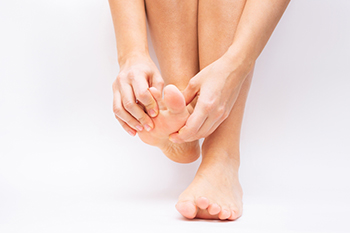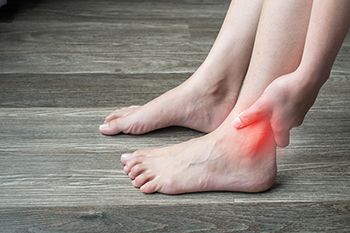Items filtered by date: August 2022
How Does the Big Toe Function?

To many people, the toes might seem like small and insignificant parts of the human body. Nothing could be further from the truth. Although the toes are small, the function that they serve, not just for the feet but for the entire body, is monumental. The big toe, for instance, has an interesting biomechanical structure that benefits other parts of the body. Also known as the hallux, the big toe helps grip the ground to provide leverage during motion activities like walking and running. Additionally, the big toe helps the feet balance when an individual puts weight on their feet. Ultimately, the big toe is what helps keep an individual from falling anytime that they stand or engage in motion activities. Without the big toe, the foot would essentially have to relearn how to balance. This would force other parts of the foot to take on the balancing function that the big toe usually has. The big toe can be susceptible to a multitude of different afflictions and foot conditions, including gout, ingrown toenails, and sesamoiditis. It is therefore critical that one takes extra care of this body part to keep it from falling prey to any of these afflictions. If you want to learn more about the function of the big toe, contact a podiatrist.
If you have any concerns about your feet, contact Patrick Bruton, DPM from Big Country foot and Ankle. Our doctor can provide the care you need to keep you pain-free and on your feet.
Biomechanics in Podiatry
Podiatric biomechanics is a particular sector of specialty podiatry with licensed practitioners who are trained to diagnose and treat conditions affecting the foot, ankle and lower leg. Biomechanics deals with the forces that act against the body, causing an interference with the biological structures. It focuses on the movement of the ankle, the foot and the forces that interact with them.
A History of Biomechanics
- Biomechanics dates back to the BC era in Egypt where evidence of professional foot care has been recorded.
- In 1974, biomechanics gained a higher profile from the studies of Merton Root, who claimed that by changing or controlling the forces between the ankle and the foot, corrections or conditions could be implemented to gain strength and coordination in the area.
Modern technological improvements are based on past theories and therapeutic processes that provide a better understanding of podiatric concepts for biomechanics. Computers can provide accurate information about the forces and patterns of the feet and lower legs.
Understanding biomechanics of the feet can help improve and eliminate pain, stopping further stress to the foot.
If you have any questions please feel free to contact our offices located in Abilene, and Brownwood, TX . We offer the newest diagnostic and treatment technologies for all your foot and ankle needs.
What Is a Plantar Fibroma?

If you are serious about protecting the health of your feet, you ought to make yourself familiar with various common foot afflictions that can negatively impact the vitality of your feet. Plantar fibroma is one of these conditions. Plantar fibroma occurs when a benign (noncancerous) tumor or nodule develops on the bottom of the foot. Most commonly, a plantar fibroma develops on the plantar fascia, the band of tissue that stretches from a person’s heel to the toes and makes up the arch of the foot. Plantar fibromas typically measure less than an inch, and they do not usually appear in an individual during the first 10 years of their life. This condition can either manifest itself as one entity or multiple entities. When plantar fibromas come in clusters and they become more invasive, this might be considered plantar fibromatosis. A plantar fibroma can be treated in various ways. One technique is to address the plantar fibroma with orthotics, or corrective shoe inserts. A surgical procedure might be needed to treat other cases of plantar fibroma. If you believe that you are suffering from plantar fibroma, consider reaching out to a podiatrist who can help you address this problem.
A plantar fibroma may disrupt your daily activities. If you have any concerns, contact Patrick Bruton, DPM of Big Country foot and Ankle. Our doctor can provide the care you need to keep you pain-free and on your feet.
Plantar Fibroma
A plantar fibroma is a fibrous knot in the arch of the foot. It is embedded in the plantar fascia which is a band of tissue that extends from the heel to the toes along the bottom of the foot. There can be multiple plantar fibromas in the feet at the same time. There are no known causes for this condition. If you have a plantar fibroma, there will be a bump in the arch of your foot that cannot be missed. Any associated pain is most often due to a shoe rubbing against the nodule. Non-surgical options, such as steroid injections, physical therapy, and orthotics should be tried first. Surgery is a last resort and is the only thing that will remove a plantar fibroma entirely. Consult with a podiatrist for a proper diagnosis and to determine the treatment regimen that is right for you.
What Causes a Plantar Fibroma?
While there are no specific causes identified, a plantar fibroma can possibly come from genetic predisposition or the formation of scar tissue that forms from healing the tears in the plantar fascia.
What Are the Symptoms of a Plantar Fibroma?
There will be a noticeable lump in the arch of the foot that may or may not cause pain. If pain is felt, it is typically because a shoe is rubbing up against the lump or when walking or standing barefoot.
Treatment and Prevention
A plantar fibroma will not disappear without treatment, but it can get smaller and be a non-issue. If pain persists, a podiatrist examines the foot and when the arch of the foot is pressed, pain can be felt down to the toes. An MRI or biopsy might be performed to help diagnose or evaluate the plantar fibroma. The following non-surgical options are generally enough to reduce the size and pain of these nodules:
- Steroid injections
- Orthotics
- Physical therapy to help apply anti-inflammatory creams on the bump
Surgery is considered if the mass increases in size and the patient continues to feel pain after non-surgical methods are tried.
If you have any questions please feel free to contact our offices located in Abilene, and Brownwood, TX . We offer the newest diagnostic tools and technology to treat your foot and ankle needs.
Edema During Pregnancy

The main issue of pregnancy affecting a woman’s feet and ankles is swelling or edema. Unfortunately, this is common and results due to hormonal changes, the production of extra blood during pregnancy, fluid retention, and circulation problems. The degree of swelling one will experience depends on various factors, such as the season of pregnancy, length of time spent on one’s feet, tightness of clothing or shoes, and time of day. Increases in progesterone slow down digestion which can lead to more fluid being absorbed in the large intestine and fluid retention. This hormone also slows down circulation and relaxes blood vessels making it easier for fluid to build up in the feet. Edema in pregnancy usually happens during the 3rd trimester, however, it can start earlier depending on the other factors discussed above. Often the swelling will continue until after birth and goes away within a few days or weeks after delivery. There is generally nothing to worry about with this type of swelling but sometimes it can signal more serious complications, like preeclampsia or deep vein thrombosis. If you have any questions as to what is normal with edema in the lower extremities during pregnancy, consult with a podiatrist who can diagnose any abnormal conditions or set your mind at ease.
Pregnant women with swollen feet can be treated with a variety of different methods that are readily available. For more information about other cures for swollen feet during pregnancy, consult with Patrick Bruton, DPM from Big Country foot and Ankle. Our doctor will attend to all of your foot and ankle needs.
What Foot Problems Can Arise During Pregnancy?
One problem that can occur is overpronation, which occurs when the arch of the foot flattens and tends to roll inward. This can cause pain and discomfort in your heels while you’re walking or even just standing up, trying to support your baby.
Another problem is edema, or swelling in the extremities. This often affects the feet during pregnancy but tends to occur in the later stages.
How Can I Keep My Feet Healthy During Pregnancy?
- Wearing orthotics can provide extra support for the feet and help distribute weight evenly
- Minimize the amount of time spent walking barefoot
- Wear shoes with good arch support
- Wear shoes that allow for good circulation to the feet
- Elevate feet if you experience swelling
- Massage your feet
- Get regular, light exercise, such as walking, to promote blood circulation to the feet
If you have any questions please feel free to contact our offices located in Abilene, and Brownwood, TX . We offer the newest diagnostic and treatment technologies for all your foot and ankle needs.
Why Is Your Ankle Feeling Wobbly and Painful?
 If you have suffered an ankle sprain that has not healed properly, and it has left your ankle ligaments overly loose, you are most likely experiencing ankle instability. A podiatrist will typically diagnose you with ankle instability if you are still experiencing weakness and laxity 6 months after an ankle sprain, or if you have suffered multiple ankle sprains. This is a common occurrence when the initial ankle sprain was not treated satisfactorily, which would have prevented it from healing properly. Ankle instability can also cause pain and tenderness, swelling and discomfort, and cause your ankle to repeatedly “give way.” Ankle instability that goes untreated may lead to chronic ankle instability, and even osteoarthritis in worst case scenarios. If you have had an ankle sprain in the past, and your ankle feels wobbly, weak, painful, or tender, there are treatments to help. It is suggested you start by having a podiatrist examine you and diagnose your condition.
If you have suffered an ankle sprain that has not healed properly, and it has left your ankle ligaments overly loose, you are most likely experiencing ankle instability. A podiatrist will typically diagnose you with ankle instability if you are still experiencing weakness and laxity 6 months after an ankle sprain, or if you have suffered multiple ankle sprains. This is a common occurrence when the initial ankle sprain was not treated satisfactorily, which would have prevented it from healing properly. Ankle instability can also cause pain and tenderness, swelling and discomfort, and cause your ankle to repeatedly “give way.” Ankle instability that goes untreated may lead to chronic ankle instability, and even osteoarthritis in worst case scenarios. If you have had an ankle sprain in the past, and your ankle feels wobbly, weak, painful, or tender, there are treatments to help. It is suggested you start by having a podiatrist examine you and diagnose your condition.
Ankle pain can have many different causes and the pain may potentially be serious. If you have ankle pain, consult with Patrick Bruton, DPM from Big Country foot and Ankle. Our doctor will assess your condition and provide you with quality foot and ankle treatment.
Ankle pain is any condition that causes pain in the ankle. Due to the fact that the ankle consists of tendons, muscles, bones, and ligaments, ankle pain can come from a number of different conditions.
Causes
The most common causes of ankle pain include:
- Types of arthritis (rheumatoid, osteoarthritis, and gout)
- Ankle sprains
- Broken ankles
- Achilles tendinitis
- Achilles tendon rupture
- Stress fractures
- Tarsal tunnel syndrome
- Plantar fasciitis
Symptoms
Symptoms of ankle injury vary based upon the condition. Pain may include general pain and discomfort, swelling, aching, redness, bruising, burning or stabbing sensations, and/or loss of sensation.
Diagnosis
Due to the wide variety of potential causes of ankle pain, podiatrists will utilize a number of different methods to properly diagnose ankle pain. This can include asking for personal and family medical histories and of any recent injuries. Further diagnosis may include sensation tests, a physical examination, and potentially x-rays or other imaging tests.
Treatment
Just as the range of causes varies widely, so do treatments. Some more common treatments are rest, ice packs, keeping pressure off the foot, orthotics and braces, medication for inflammation and pain, and surgery.
If you have any questions, please feel free to contact our offices located in Abilene, and Brownwood, TX . We offer the newest diagnostic and treatment technologies for all your foot care needs.
Keep Your Feet Healthy So You Can Stay Active
Signs of Ankle Sprains and Strains

It can be difficult to determine whether an ankle injury is a sprain or a strain, because the symptoms are similar. Common to both strains and sprains are ankle pain, swelling, and instability. However, differences in the location of the pain and its side effects can help to indicate whether a muscle or a ligament is the cause. A strain occurs when the muscles and/or tendons in the ankle joint are stretched or torn, usually as a result of overuse. In a sprain, however, the ligaments in the affected area are torn or stretched beyond their normal range of motion. With a sprain, intense pain followed by swelling will be experienced at the site of the injury. A popping sound is likely to be heard. Bruising at the site may also occur, and there is likely to be a decrease in mobility. With a strain, the pain may be acute or appear gradually. Muscle cramps, spasms, and general weakness are common. If you are experiencing any of the above symptoms, it is wise to consult a podiatrist for a complete exam and diagnosis because ignoring the condition could lead to chronic ankle problems.
Ankle sprains are common but need immediate attention. If you need your feet checked, contact Patrick Bruton, DPM from Big Country foot and Ankle. Our doctor can provide the care you need to keep you pain-free and on your feet.
How Does an Ankle Sprain Occur?
Ankle sprains take place when the ligaments in your ankle are torn or stretched beyond their limits. There are multiple ways that the ankle can become injured, including twisting or rolling over onto your ankle, putting undue stress on it, or causing trauma to the ankle itself.
What Are the Symptoms?
- Mild to moderate bruising
- Limited mobility
- Swelling
- Discoloration of the skin (depending on severity)
Preventing a Sprain
- Wearing appropriate shoes for the occasion
- Stretching before exercises and sports
- Knowing your limits
Treatment of a Sprain
Treatment of a sprain depends on the severity. Many times, people are told to rest and remain off their feet completely, while others are given an air cast. If the sprain is very severe, surgery may be required.
If you have suffered an ankle sprain previously, you may want to consider additional support such as a brace and regular exercises to strengthen the ankle.
If you have any questions please feel free to contact our offices located in Abilene, and Brownwood, TX . We offer the newest diagnostic and treatment technologies for all your foot and ankle needs.

